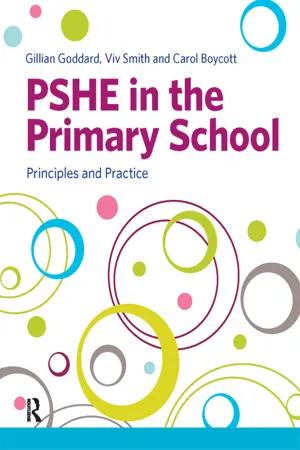![]()
Chapter 1
An introduction to Personal, Social, Health and Economic (PSHE) education
Chapter objectives
This chapter
Explains what PSHE is and how it has developed in primary schools
Gives a rationale for the presence of PSHE in schools
Outlines the political factors in the debate for PSHE in schools
What is Personal, Social, Health and Economic education?
Reflection point
Take time to consider what you think personal and social education is exactly. If a parent asked you to explain what this ‘PSHE thing’ is, how would you answer? Jot down a few notes giving examples of the types of themes or activities that could be classed as PSHE.
The Macdonald Review of Personal, Social, Health and Economic education (DCSF 2009b: 16) proposed that ‘effective PSHE should equip children and young people with the knowledge, understanding, attitudes and practical skills to live healthy, safe, productive and fulfilled lives.’
This in many ways mirrors the earlier definition taken from the national curriculum (DfEE 1999).
Personal, social and health education and citizenship help to give pupils the knowledge, skills and understanding they need to lead confident, healthy, independent lives and to become informed, active, responsible citizens.
DfEE/QCA 1999: 136
It is notable that these two definitions give less of a description and more of a summary of the outcomes or benefits of good PSHE.
Reflection point
How do you react to these outcomes or purposes? Do you see them being addressed in schools today? Were they present in your schooling as a child? Perhaps more importantly, you might want to discuss or think about whether you fundamentally agree with having PSHE in primary education. Should primary teaching be about achieving these outcomes, or should it be more limited, more subject or knowledge focused?
This discussion has still not brought us closer to understanding what exactly PSHE is. One of the earliest official definitions may be the clearest. It came from a guidance booklet for schools on the subject of PSHE produced by the government appointed but independent Her Majesty’s Inspectors of Schools (HMI) in 1989.
Personal and Social Education is concerned with qualities and attitudes, knowledge and understanding and abilities and skills in relation to oneself and others, social responsibilities and morality.
HMI 1989: para 4, p.1
This definition is precise in that teaching PSHE involves not only transmitting knowledge and giving children opportunities to develop and practise their skills but also concerns the instilling of attitudes and values. This is what makes it so hard to teach and assess because it is not just about facts but about beliefs, moral principles and behaviours and attitudes.
Essentially, PSHE consists of two equally important components, personal education and social education.
Personal education
Personal education is concerned with self-knowledge, self-acceptance and valuing of the self as well as the acquisition of skills in keeping well and safe. It includes work as prosaic as personal hygiene and as demanding as safeguarding oneself from paedophilic lures, to the enhancement of personal resilience and maintenance of self-belief and self-respect. It encompasses self-motivation, cultivating independence and developing gifts and talents.
Social education
Social education centres on interpersonal skills and attitudes in a range of social situations, e.g. friendship, cooperative groups, emerging sexual relationships, working together, leadership and following. Skills include communication, assertiveness and compromise, empathy, emotional literacy and making moral choices in the treatment of others and their property. Values and attitudes include acceptance of difference, loyalty, empathy and respect. It also involves the development of skills associated with resisting peer and media pressure to engage in unhealthy or risky activities. In its broadest definition, it also requires active participation as a global, national and local citizen.
How is it delivered in school?
QCA (2000) guidance on PSHE recommended a whole school approach and delivery through four types of delivery: discrete curriculum time, such as in designated PSHE timetabled lessons or regular circle time, via other curriculum subjects, such as RE, literacy, history or science, through PSHE events and activities such as anti-bullying week and through the development of pastoral care systems. These remain the key ways PSHE is delivered in most schools (NCB 2006). This will be discussed in more depth in the next chapter.
A second process is embedded in the delivery of PSHE however. This is referred to as the hidden curriculum. It is the lessons subconsciously passed on to pupils when they witness and experience the way members of the school staff treat the pupils and each other. These covert messages about how to behave and what is important in life are projected by the school in its organisation, its routines and rules (Pring 1984). It can be sensed in the ethos of the school, but essentially it revolves around relationships and modelling. This hidden curriculum is more powerful and more effective than overt teaching simply because it is unconsciously received and therefore remains largely unquestioned or challenged.
Reflection point
Think for a few moments about your own schooling as a child. What messages did your school give to you through the way they treated you or other pupils, or what they allowed in the way pupils treated each other? Did you have any explicit teaching on PSHE themes? Did it run counter to those hidden messages? An example might be an assembly where the school pupils are told that ‘we all respect each other and are polite in this school’, then a teacher shouts directly in the face of a child for making a mistake and calls them ‘stupid’. Which of these two messages is likely to stay with that child as the real one?
A history of the development of PSHE in the English primary curriculum
Awareness of instilling moral values and insisting on moral behaviour in children were always present from the emergence of compulsory schooling in the late nineteenth century. RE was the principal curriculum route for moral education, but mostly these concepts of right and wrong were acquired through the simple and powerful lessons learnt from the application of occasional rewards and many severe punishments. A full century later, in the late 1980s, physical punishment was made illegal in state schools (1986), then all schools (1998) and emphasis was placed on the management of behaviour (and thus the instillation of moral values) by the application of sanctions or withholding of privileges (NSPCC 2009). However, the Bulger case (1993), where two primary-aged boys kidnapped a two-year-old and tortured him to death, prompted the then government to instruct Ofsted, its schools inspection agency, to make explicit judgements about the effectiveness of a school’s moral education as witnessed in behaviour and personal values of children in the playground and classroom. This sat rather incongruously with the main inspection focus which at that time was standards of English and maths. Modern references in official circles now tend to concentrate more on behaviour, especially behaviour for learning, than moral education, but it is still a primary driver in schools and a critical requirement of most parents that children be taught right from wrong in school and be encouraged, some would say made, to behave accordingly. Much social education undertaken in schools centres on the treatment of others.
If moral education has been in place since the nineteenth century then other aspects of PSHE came more to the fore in the 1970s when the anti-discrimination agenda of the Labour government (race, class and gender) filtered down into education, thus issues of inequality were officially addressed with anti-sexist and anti-racist education programmes and policy reform.
PSHE as a discrete subject emerged in the 1980s with seminal authors in the field such as Pring (1984) and Lang (1988). PSHE at this time was mostly delivered through the hidden curriculum but units of Health Education (anti-smoking, sex, drugs education) were beginning to appear in some primary schools, despite their controversial nature. The rising acceptance of PSHE as a subject is reflected in the publication of the HMI Curriculum Matters Series: Personal and Social Education in 1989, just as implementation of the new centrally and politically determined National Curriculum (DoE 1989) effectively killed it off. Ironically, the national curriculum did refer to PSHE as a cross-curricular dimension to be woven through the ten-subject curriculum delivery but it proved ultimately tokenist as schools struggled to deliver an over-weighty, legally-enforceable subject curriculum.
Other influences in the 1990s kept PSHE at bay, particularly the aforementioned Conservative government’s ‘back to basics’ agenda even though the Education Reform Act (1988) had an aim which encompassed a broad approach to children’s learning. The development of inclusive education practice was also beginning to emerge through the 1990s and this directly challenged stereotyping and discrimination again, particularly for those with learning or physical disabilities (UN Salamanca Statement 1994; DfES Excellence for All Green Paper 1997).
By the end of that decade the new Labour government established an Advisory Group to consider whether citizenship should be part of the formal school curriculum. It reported in 1998 with the recommendation that citizenship should become statutory (Citizenship Advisory Group 1998). Schools were consulted but rejected the proposal on grounds that the curriculum was already overloaded. In the end the government accepted this in part and provided a non-mandatory syllabus on the back of their newly revised National Curriculum Guidance for primary schools (DfEE 1999). Citizenship, however, was introduced compulsorily at secondary school level from 2002 in an attempt to address young people’s disengagement in political and democratic processes. It is interesting that since the 2011 summer riots, citizenship education is again becoming high profile. Like the Bulger case, when there is a public moral crisis concerning the behaviour of children, young people and adults, the press and the government turn to schools to solve the problem.
Simultaneously with the r...




